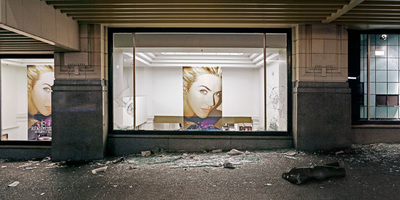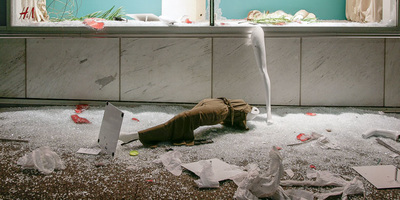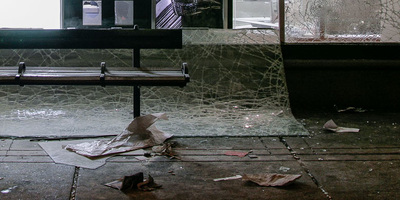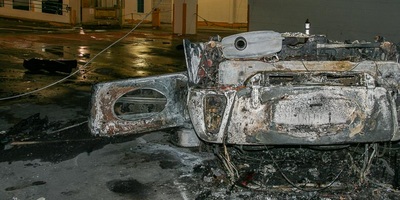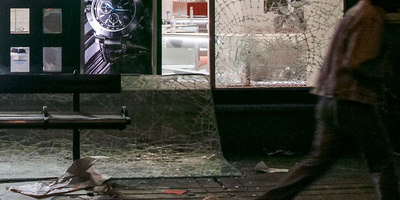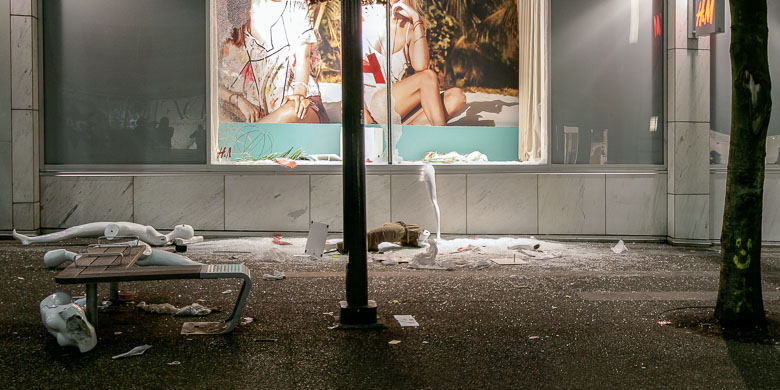riot night in canada: vancouver, june 2011
civility fractured
civility fractured
The initial photographs have been partially re-imagined and are presented cropped, refragmented, fractured, to establish a complementary relation between elements of form and content. A fragmented\fractured style to portray, and correspond to, a moment of fractured civility.
In as much as some of the store windows displayed mannequins -mostly of female figures-, and commercialized images of alluring femininity, the resulting violence also portrays an implicit aggression, intended or not, towards the human (female) body.
gallery and full text below:
Riot Night in Canada: Vancouver, June 2011
A riot is civility fractured. It is a violent infraction of an agreed-upon social contract. There are times when reasons exist to want a fracturing, or disruption, of an established socio-political order, or of a forced sense of civility that may be deemed repressive by, and to, members at large -as when oppressive transgressions are inflicted on basic human principles of dignity and democracy. Those are moments for social protest, upheaval and revolution that may be understandable and deemed justified. There are certainly other valid instances where members of society may feel marginalized, disenfranchised, or wronged by social or corporate structures, but that those feelings should warrant the eruption of civil violence within a social environment generally deemed unthreatening, economically stable, democratic, and in many ways exemplary, is harder to understand.
In the spring on 2011, a riot took place in the city of Vancouver, Canada, as a result of the loss of a hockey game –the loss of a hockey game. It was an important game, as far as hockey games go, in a place where the sport can stir up nationalistic fervor. It was the final game of the acclaimed and worshiped Stanley Cup in a city starving for, and denied, sport success for decades.
In many ways it was a riot foretold. A similar championship loss had triggered a similar event years before. This time around, for several days, during preliminary elimination games, crowds had been encouraged to gather and occupy the streets surrounding the stadium. The city had provided, fashioned, a collective space designed for group enjoyment and celebration. Those who could not attend the games could watch them en masse on large outdoor screens. All in an ingenuous attempt by civic officials to recreate the enthusiasm and spirit that had peacefully engulfed the city a few months before when it proudly celebrated the Winter Olympics. Somehow, it was thought that the local and national feeling of elation provided by the success in a variety of Olympic sports could be duplicated. No consideration was apparently given to the potentiality for defeat and its repercussions, or to the different nature of the event itself – the culmination of an increasingly aggressive hockey final series where sport can easily deteriorate into base pugilism. Certainly, by the time the last game was being played, and being lost, in Vancouver, the mood of hostility in the rink had crept into the streets.
As the local team was defeated inside the arena, outside, in the downtown streets, by plan or impromptu circumstance, agitators proceeded to vandalize the immediate surroundings charging parked automobiles and store fronts. In a compounded frenzy, and seemingly impelled by varying levels of anger and unrestrained self-indulgence, they rolled and set cars on fire and reduced street level commodity businesses to glass shards and wreck. In as much as the police, in a perplexing initial decision, took on an observing role and a position of non-intervention, it could be argued that the ensuing riot was, partially at least, enabled, if not sanctioned.
The riot became not only an overt act of destruction by dissident elements, but also an act of looting, an act of theft, by otherwise, and under normal circumstances, law abiding individuals. In a strange turn of events, the social puissance or mob mentality of the gathered mass, herded within the collective space of blocked streets artificially demarcated for the occasion, overturned the expected celebratory mood and, in a possibly uncharacteristic, but seemingly instinctive manner, lead people to over-react. What the cause of the reaction may have been is not entirely clear. It is not reasonable to think that it was simply a reaction to the loss of a hockey game. It would seem to have been a reaction to an unspecified and accumulated sense of alienation, dissatisfaction and indulgence by some, exacerbated by the emotion of the loss, and possibly enhanced by the estranged commodified space people found themselves in, and which in normal circumstances they would civically accept or even embrace.
The images in this series are not of the riot itself, but rather of its immediate aftermath. As they show, the targets of the destruction are predictable, essentially unavoidable in the context of civic space, and nonetheless suggestive: automobiles and store windows displaying the usual assortment of desired consumer goods; the most tangible and immediately accessible representations of consumerism and social divide. In as much as some of the store windows displayed mannequins -mostly of female figures-, and commercialized images of alluring femininity, the resulting violence also portrays an implicit aggression, intended or not, towards the human (female) body.
The initial photographs have been partially re-imagined and are presented cropped, refragmented, fractured, to establish a complementary relation between elements of form and content. A fragmented\fractured style to portray, and correspond to, a moment of fractured civility.
all images copyright © enrique manchon 2011
